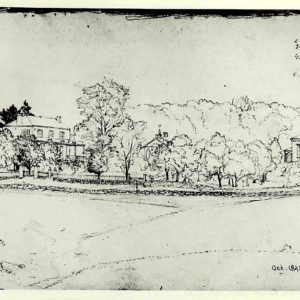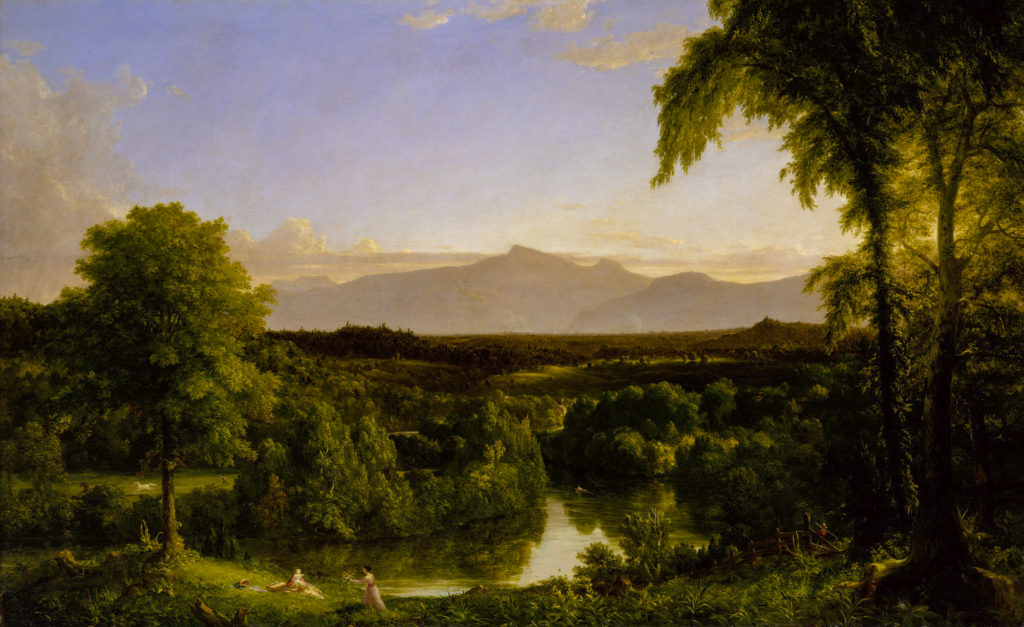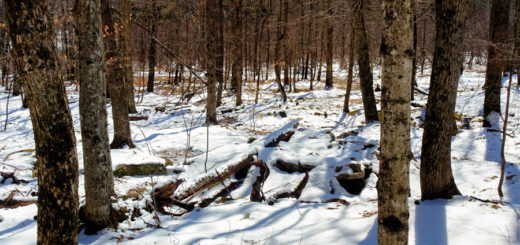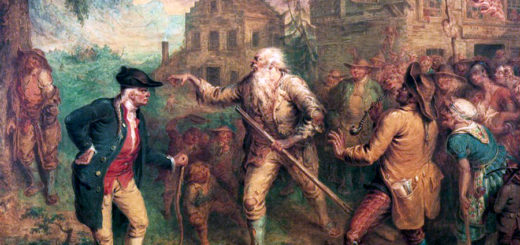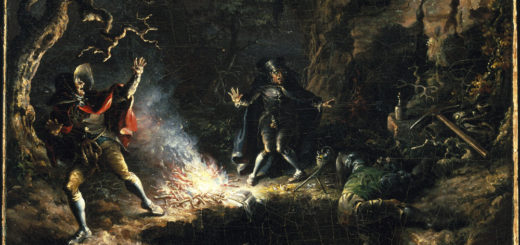An Artist’s Privy
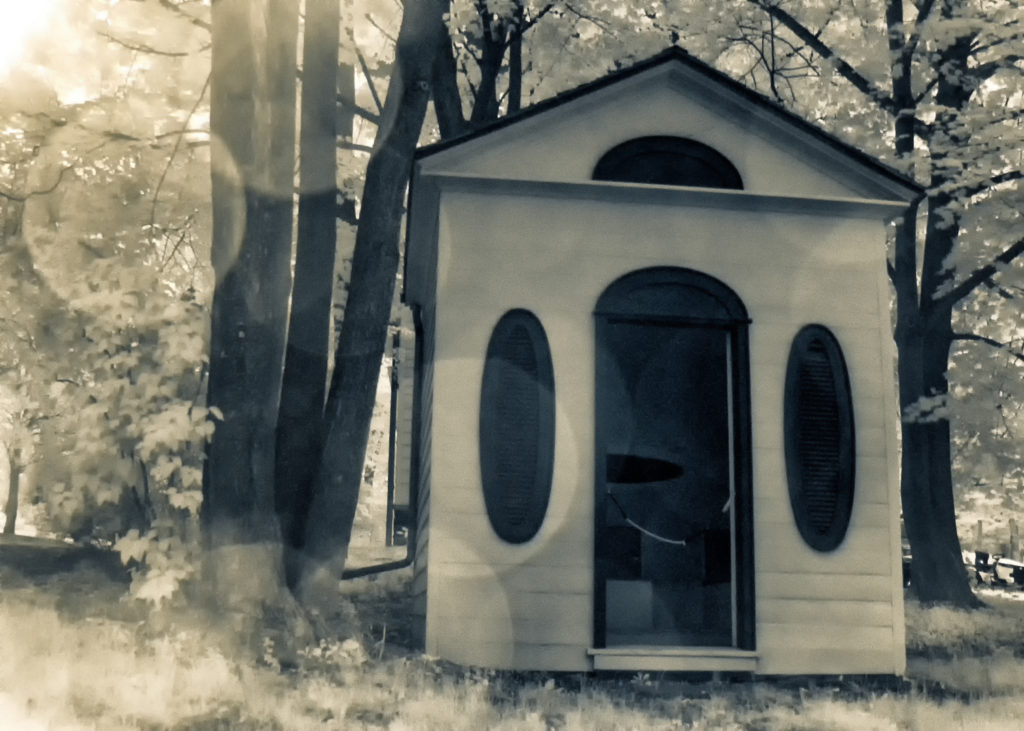 Cedar Grove was the home of Thomas Cole from 1836, when he married the proprietor’s niece, until 1848, when the artist unexpectedly died of a lung ailment. Of the original structures that adorned the 110 acre farm along a hill above the village of Catskill, only three remain on the now 3.4 acre National Historic Site: the main house, the storehouse studio, and a privy. In addition to these structures, a fourth—Cole’s new studio, a building he designed himself and had constructed in 1846—also stood on the property up until the 1970s, when it was unceremoniously torn down. In recent years, amid great fanfare, an exact replica of the new studio has been erected on the original site. A sketch made by Cole’s student Frederic Church in October of 1848 depicts Cedar Grove from the fields just below the road fronting the homestead. Three of the buildings are visible in this sketch: the house on the left, the new studio on the right, and in the middle—largely obscured by trees—the privy. The scene today is not all that different from how Church rendered it, save for the steady stream of automobile traffic on Spring Street and a greater obscurity of trees, which now blocks any view of the privy from that direction. For those with a curiosity for the past, an ample and ever-increasing accumulation of historical documentation about Cedar Grove is available for consultation—as long as it’s only the house, the storehouse studio, or the new studio (both the original and the replica) that you’re interested in. Sad to report, but if it’s the privy—a remarkable three-seater designed in the Federal style—that you wish to investigate, well, you are out of luck. A great shame really, as—to quote a young archivist of my acquaintance—“It’s a place with a lot of memories.”
Cedar Grove was the home of Thomas Cole from 1836, when he married the proprietor’s niece, until 1848, when the artist unexpectedly died of a lung ailment. Of the original structures that adorned the 110 acre farm along a hill above the village of Catskill, only three remain on the now 3.4 acre National Historic Site: the main house, the storehouse studio, and a privy. In addition to these structures, a fourth—Cole’s new studio, a building he designed himself and had constructed in 1846—also stood on the property up until the 1970s, when it was unceremoniously torn down. In recent years, amid great fanfare, an exact replica of the new studio has been erected on the original site. A sketch made by Cole’s student Frederic Church in October of 1848 depicts Cedar Grove from the fields just below the road fronting the homestead. Three of the buildings are visible in this sketch: the house on the left, the new studio on the right, and in the middle—largely obscured by trees—the privy. The scene today is not all that different from how Church rendered it, save for the steady stream of automobile traffic on Spring Street and a greater obscurity of trees, which now blocks any view of the privy from that direction. For those with a curiosity for the past, an ample and ever-increasing accumulation of historical documentation about Cedar Grove is available for consultation—as long as it’s only the house, the storehouse studio, or the new studio (both the original and the replica) that you’re interested in. Sad to report, but if it’s the privy—a remarkable three-seater designed in the Federal style—that you wish to investigate, well, you are out of luck. A great shame really, as—to quote a young archivist of my acquaintance—“It’s a place with a lot of memories.”
Historians’ neglect of the artist’s “place of easement” at Cedar Grove is surprising, given the enduring position occupied in the public imagination by comparable outhouses. A popular form of treasure hunting nowadays is called “privy digging,” a practice that emerged in the 1970s. It involves locating and burrowing into the vaults of defunct outhouses for “interesting and suggestive items” such as old bottles, broken pottery, coins, and the occasional wedding ring. Among the more notable privies to be excavated is that of the great religious reformer Martin Luther—at a monastery in Wittenberg, Germany. Brother Martin (1483-1546), as the story goes, was a stout monk of the Augustinian Order who suffered from chronic constipation. One day in the early 16th century, while sitting in the privy, the good monk was struck, out of the blue, with the fundamental insight that launched the Protestant Reformation. Or to recount the episode in his own words, loosely translated: “The holy spirit imparted this creation to me in the loo.” Dig into the word “privy” itself for linguistic origins and you will find that it shares a root with “paradise”—in the sense that both terms indicate a type of enclosure. Thus as a place—whether it be in a backyard or in a dictionary—a privy is not without its own genius.
As an artist, Thomas Cole was possessed of the notion of paradise, or more specifically, Eden. The landscape paintings for which he is famous—all of them from “Lake with Dead Trees” (1825) to “Home in the Woods” (1847)—play with this idea in one way or another. Within the enclosure of their frames, each of Cole’s landscape paintings affords the viewer a place of imagination, wherein a pristine America might yet be recovered—or better yet, discovered for the first time. Cole’s was an artistic vision in which virginity, it could be said, becomes a renewable resource. “Nature has spread for us a rich and delightful banquet,” he writes in his “Essay on American Scenery” (1837). “Shall we turn from it? We are still in Eden; the wall that shuts us out of the garden is our own ignorance and folly.”
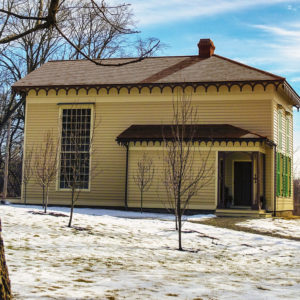 Yet underlying this happy vision of a Paradise nearly at hand is a more pessimistic take on the America of his day. “I am predisposed to melancholy,” he confesses in the privacy of his journal, at about the same time he’s writing the “Essay.” “I often think that the dark view of things is the true one; we could not live if such truth was always present & heaven has granted us a sunshine of the heart that warms up the barrens & cold reality & dazzles that we may enjoy & live.” The journal, in fact, is regularly punctuated with laments of paradises lost. Close by to Cedar Grove was a favorite dell in which Cole would walk with his future wife—Maria—and her sisters. He describes it as “having a meadow-like margin which sometimes widens into the area of a little amphitheatre of woods which are of varied foliage.” The stream running through this vale was full of small fish “who, one would suppose, lead a quiet and contented life & for a spirit of seclusion & tranquility seem to dwell in this little valley.” On a stroll through this seeming Eden on November 6, 1834, they “heard the shouts of a company of Jacksonians who were rejoicing at the defeat of the Whigs in this county. Why were they rejoicing? because of the triumph of good principles or the cause of virtue & morality? No! but because their party was victorious!” Alas, Paradise invaded by the serpent of rabble politics.
Yet underlying this happy vision of a Paradise nearly at hand is a more pessimistic take on the America of his day. “I am predisposed to melancholy,” he confesses in the privacy of his journal, at about the same time he’s writing the “Essay.” “I often think that the dark view of things is the true one; we could not live if such truth was always present & heaven has granted us a sunshine of the heart that warms up the barrens & cold reality & dazzles that we may enjoy & live.” The journal, in fact, is regularly punctuated with laments of paradises lost. Close by to Cedar Grove was a favorite dell in which Cole would walk with his future wife—Maria—and her sisters. He describes it as “having a meadow-like margin which sometimes widens into the area of a little amphitheatre of woods which are of varied foliage.” The stream running through this vale was full of small fish “who, one would suppose, lead a quiet and contented life & for a spirit of seclusion & tranquility seem to dwell in this little valley.” On a stroll through this seeming Eden on November 6, 1834, they “heard the shouts of a company of Jacksonians who were rejoicing at the defeat of the Whigs in this county. Why were they rejoicing? because of the triumph of good principles or the cause of virtue & morality? No! but because their party was victorious!” Alas, Paradise invaded by the serpent of rabble politics.
Another time, while on an excursion to the spectacular environs of the Catskill Mountain House, Cole found his anticipated Paradise overrun with a crowd of fashionable tourists. “There was much company & as usual in such places few that enjoyed the magnificence that nature spread around them. They seemed to have no object, no project for enjoyment. Some of the ladies were riding headless and tailless. Hobby horse were propelled ‘round by several industrious gentlemen. One party of men was engaged in the intellectual game of ninepins and half a dozen ladies & as many of the other sex were dancing in a long room, where there was a mangle [i.e., a clothes ringer] in one corner, to the sound of something like a three-stringed fiddle. What a desecration of the place where nature offers a feast of higher, holier enjoyment! Alas that men should thrust their frivolities in the very face of the sublimest regions of the world! We turned away disgusted & sought pleasure where we were sure to find it pure, healthful & unalloyed.” Paradise for Cole—at least on that occasion—was regained by taking a short walk down the hill to the still-unsullied waters of North and South Lakes.
Yet another time—and most famously—Cole came upon paradise ravaged by a new railroad. On August 1, 1836 he writes: “Last evening I took a walk up the Catskill above Austin’s Mill where the Rail Road is now making. This was once a favorite walk but the charm and quietness & solitude is gone; it is still lovely; man cannot remove the mountains & he has not yet felled all the woods & the stream will have its course. If men were not so insensible to the beauty of nature the great works necessary for the purpose of commerce might be carried on without destroying it, and times might even contribute to her charms by rendering her more accessible; but it is not so. They desecrate whatever they touch. They cut down the forests with a wantonness for which there is no excuse, even gain, & leave the herbless rocks to glimmer in the burning sun.” And a decade later, not long before his death, Cole again is reflecting upon the same theme: “The hurry, noise & restlessness of Rail Road travelling with the consequent violence done to the natural requirements of the body are anything but conducive to health of body or serenity of mind. The body is made to be merely a sort of Tender to a Locomotive Car; its appetites & functions wait on a Machine which is merciless & tyrannical.” With only the slightest of revision, Cole’s words might well apply today. The afflictions to health of body and serenity of mind by our gadgetry only seem to have been piled higher and deeper upon us.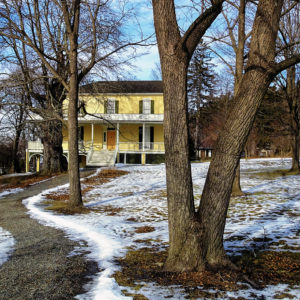
Yes, it’s easy to regard the often cruel sweep of American history—then survey the current state of the lands and waters that inspired Cole’s art and see now the industrial quarries, the graceless big box stores, and the ill-thought grounds of incarceration—and conclude that Paradise indeed has been lost, again and again and again. The world, we say, has gone to the crapper. Alas, Cole’s words from 1835 still ring true: “It appears to me that the moral principle of the nation is much lower than formerly—much less than vanity will allow—Americans are too fond of attributing the great prosperity of the country to their own good government instead of seeing the source of it in the unbounded resources and favorable political opportunities of the nation.”
Even so, it remains incumbent upon each of us to look again. Look again at Cole’s inspired art and see what he saw despite the hooting of politics, the slovenly disregard of vacationing pleasure-seekers, and the incursion of the iron serpent into a sacred glen. Look again at a painting such as View on the Catskill—Early Autumn, a work he created at the very same time he was decrying the desecration wrought by the railroad. Look again at the blue mountains to the west that “recede like steps by which we may ascend to a great temple, whose pillars are those everlasting hills, and whose dome is the blue boundless vault of heaven.” Look again.
Such musings bring to mind a memory or image, from some years back, of a long-abandoned privy happened upon in the unmapped recesses of a Catskill Mountain forest. The teetering structure was perched on a bluestone ledge not far, perhaps, from where Rip Van Winkle took his twenty-year nap and dreamed his twenty-year dream. The door of the ancient privy had come off its hinges and lay moldering upon the ground. Visible through the opening was the rotting bench and its perilous hole, behind which on the wall was a fading sign. In elegant old lettering it read: “Another world there is, but it’s inside this one.” Here at last was a Paradise fit for an artist.
©John P. O’Grady
Originally appeared in The Mountain Eagle on June 14, 2019
